 Photographic portrait of nature photographer Ansel Adams — which first appeared in the 1950 Yosemite Field School yearbook. The camera is probably a Zeiss Ikon Universal Juwel. Via Wikipedia.
Photographic portrait of nature photographer Ansel Adams — which first appeared in the 1950 Yosemite Field School yearbook. The camera is probably a Zeiss Ikon Universal Juwel. Via Wikipedia.
Who was Ansel Adams?
Ansel Easton Adams, born on February 20, 1902, and passed away on April 22, 1984, was a renowned American photographer and conservationist. He gained recognition for capturing black-and-white photographs of the landscapes in the American West. Adams played a significant role in the formation of Group f/64, an association of photographers dedicated to promoting "pure" photography, characterized by sharp focus and the comprehensive use of tonal range in images. Collaborating with Fred Archer, Adams developed the Zone System, a technique that involved understanding the tonal range of an image and making informed choices in exposure, negative development, and printing to achieve the desired final print.
Throughout his life, Adams was a devoted supporter of environmental conservation, and his photographic work was deeply intertwined with his advocacy efforts. At the age of 12, during his initial visit to Yosemite National Park, he received his first camera. He began his photographic journey as a member of the Sierra Club and later collaborated with the United States Department of the Interior to capture photographs of national parks. In recognition of his contributions to expanding the National Park system and his persistent advocacy, Adams was honored with the Presidential Medal of Freedom in 1980.
Furthermore, Adams played a crucial advisory role in the establishment of the photography department at the Museum of Modern Art in New York. This development marked a significant milestone in securing institutional recognition for photography. He actively participated in organizing the department's inaugural photography exhibition, co-founded the photography magazine Aperture, and was instrumental in establishing the Center for Creative Photography at the University of Arizona.
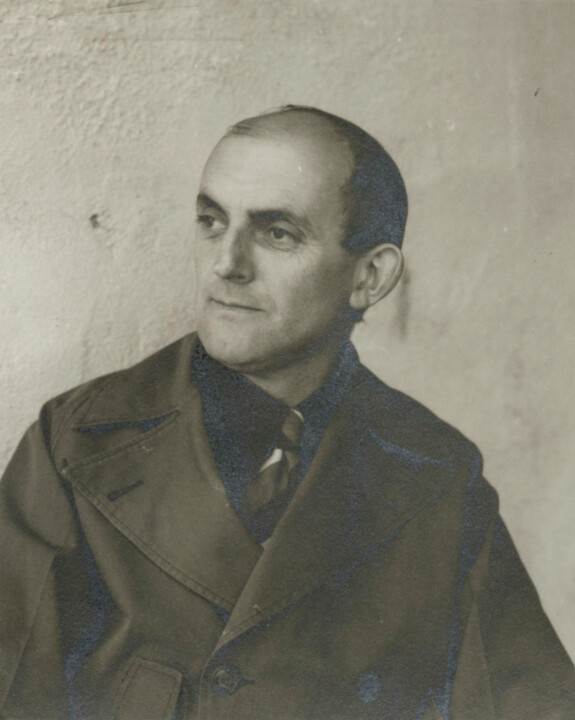 Adams c. 1941, via Wikipedia.
Adams c. 1941, via Wikipedia.
Early childhood and education
Ansel Easton Adams, born in San Francisco's Fillmore District, was the sole child of Charles Hitchcock Adams and Olive Bray. He was given the name Ansel Easton after his uncle. Olive's family hailed from Baltimore, where her grandfather had a thriving freight-hauling business that unfortunately led to financial ruin due to failed investments in mining and real estate ventures in Nevada. The Adams family originated from New England, having migrated from Northern Ireland in the early 18th century. Ansel's paternal grandfather established a prosperous lumber business, which his father later managed. In his later years, Ansel expressed his disapproval of the industry that his grandfather had been involved in, as it contributed to the depletion of the magnificent redwood forests. One of Ansel's earliest memories was witnessing the smoke rising from the fires caused by the 1906 San Francisco earthquake. Although he was unharmed during the initial tremors, he was thrown face-first into a garden wall by an aftershock three hours later, resulting in a broken nose and a lifelong need to breathe through his mouth. A doctor suggested resetting his nose once he reached adulthood, but it remained crooked, leaving him with the necessity of mouth breathing throughout his life.
In 1907, his family relocated to a new residence near San Francisco's Seacliff neighborhood, just south of the Presidio Army Base. The new home boasted a magnificent view of the Golden Gate and the Marin Headlands.
Ansel was a hyperactive child and frequently fell ill, prone to hypochondria. He had few friends, but the natural beauty surrounding his family home on the heights overlooking the Golden Gate provided ample opportunities for childhood exploration. While he lacked interest in games or sports, he had a deep appreciation for nature from an early age, collecting insects and venturing to Lobos Creek, Baker Beach, and the sea cliffs leading to Lands End—a stretch of San Francisco's rugged and untamed coastline characterized by shipwrecks and landslides. Ansel's father owned a three-inch telescope, and their shared passion for astronomy led them to visit the Lick Observatory on Mount Hamilton together. In fact, Charles Adams served as the paid secretary-treasurer of the Astronomical Society of the Pacific from 1925 to 1950.
After the death of Ansel's grandfather following the Panic of 1907, Charles Adams faced substantial financial losses in his business. Some of the loss was attributed to Ansel's uncle Ansel Easton and Cedric Wright's father, George, who covertly sold their shares in the company, thereby providing controlling interest to the Hawaiian Sugar Trust for a considerable sum of money. By 1912, the family's standard of living had drastically declined.
Ansel faced dismissal from several private schools due to restlessness and inattentiveness. Consequently, when he turned 12, his father decided to withdraw him from school. For the following two years, Ansel received education from private tutors, his aunt Mary, and his father. Mary was an admirer of Robert G. Ingersoll, a 19th-century agnostic and advocate for women's suffrage, and his teachings played a significant role in Ansel's upbringing. During the Panama–Pacific International Exposition in 1915, Ansel's father insisted that he spend part of each day studying the exhibits as part of his education. Eventually, he resumed his formal education by attending Mrs. Kate M. Wilkins Private School, graduating from the eighth grade on June 8, 1917. In his later years, he displayed his diploma in the guest bathroom of his home.
Ansel's father instilled in him the values championed by Ralph Waldo Emerson, encouraging him to lead a modest, ethical life that honored social responsibility towards both humanity and the natural world. Ansel shared a loving bond with his father but had a distant relationship with his mother, who disapproved of his interest in photography. Following his mother's death in 1950, Ansel engaged in a disagreement with the undertaker while selecting a casket for her burial. He chose the least expensive option in the room, a $260 coffin, feeling it was the minimum he could do without undertaking the task himself. The undertaker commented, "Have you no respect for the dead?" To which Ansel replied, "Make one more remark like that, and I will take Mama elsewhere."
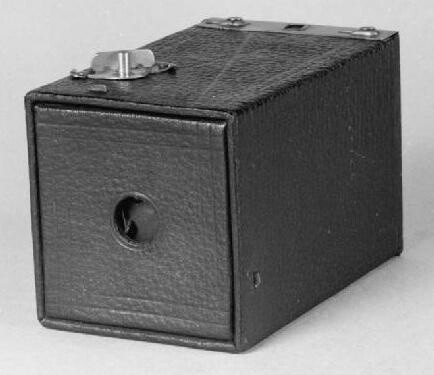 Kodak No 1 Brownie Model B box camera, the first model Adams owned, via Wikipedia.
Kodak No 1 Brownie Model B box camera, the first model Adams owned, via Wikipedia.
Youth
At the age of 12, Adams developed an interest in playing the piano after hearing his 16-year-old neighbor, Henry Cowell, play on the piano at his own home. Intrigued, Adams taught himself how to play and read music. Cowell, who later became a renowned avant-garde composer, provided Adams with some lessons. Over the next decade, three music teachers mentored him, urging him to refine his technique and discipline. As a result, Adams grew determined to pursue a career as a classical pianist.
In 1916, Adams made his first visit to Yosemite National Park with his family. He vividly described his initial experience of the valley, stating that it was a breathtaking sight that filled them with wonder and awe. The beauty of Yosemite left a lasting impression on him, marking the beginning of a new chapter in his life. During that trip, his father gifted him his first camera, an Eastman Kodak Brownie box camera. Adams, fueled by his characteristic enthusiasm, took his initial photographs during that time. The following year, he returned to Yosemite on his own, equipped with better cameras and a tripod. In the winters of 1917 and 1918, he worked part-time for a San Francisco photo finisher, where he acquired essential skills in darkroom technique.
Unfortunately, Adams contracted the Spanish flu during the 1918 pandemic, requiring several weeks to recover. The experience left a profound impact on him, leading to an obsession with cleanliness. He developed a fear of touching anything without immediately washing his hands afterward. Despite objections from his doctor, Adams persuaded his parents to take him back to Yosemite. Surprisingly, the visit not only cured him of his illness but also alleviated his compulsions.
Adams was an avid reader of photography magazines, regularly attended camera club meetings, and frequently visited photography and art exhibitions. He explored the High Sierra region during both summer and winter seasons with Francis Holman, a retired geologist and amateur ornithologist whom he affectionately referred to as "Uncle Frank." Holman imparted his knowledge of camping and climbing to Adams. However, their shared lack of expertise in safe climbing techniques, such as belaying, led to several close calls with disaster.
While in Yosemite, Adams required a piano for practice. A ranger introduced him to landscape painter Harry Best, who had a studio home in Yosemite and resided there during the summers. Best generously allowed Adams to practice on his old square piano. Adams became interested in Best's daughter, Virginia, whom he later married. Following Best's passing in 1936, Virginia inherited the studio and operated it until 1971. Today, the studio is known as the Ansel Adams Gallery and remains in the ownership of the Adams family. At the age of 17, Adams joined the Sierra Club, an organization dedicated to preserving the Earth's wild places. He worked as the summer caretaker of the Sierra Club visitor facility in Yosemite Valley, known as the LeConte Memorial Lodge, from 1920 to 1923. Adams maintained his membership in the Sierra Club throughout his life and served as a director, as did his wife. He was elected to the Sierra Club's board of directors in 1934 and held the position for 37 years. Adams actively participated in the club's annual High Trips, eventually becoming the assistant manager and official photographer for these excursions. He is credited with achieving several first ascents in the Sierra Nevada.
During his twenties, many of Adams's friends had connections to the music world, including Cedric Wright, a violinist and amateur photographer who became his closest friend and cultural mentor. Their shared philosophy stemmed from Edward Carpenter's work, "Towards Democracy," which emphasized the pursuit of beauty in both life and art. For a number of years, Adams carried a pocket edition of the book with him during his time in Yosemite, and it became a personal guiding philosophy. Adams later expressed his belief in beauty, acknowledging the significance of stones, water, air, soil, people, and their future and destiny.
During the summer months, Adams embraced a lifestyle of hiking, camping, and photography, while dedicating the remainder of the year to improving his piano skills. He diligently honed his technique and musical expression. To supplement his income, he also provided piano lessons. With the extra funds, he was able to purchase a grand piano that suited his musical aspirations. Despite still harboring ambitions for a career in music, Adams began to recognize the limitations imposed by his relatively small hands. While respected judges considered him a talented pianist, his involvement in the Milanvi Trio, comprising a violinist and a dancer, revealed his shortcomings as an accompanist. It took him an additional seven years to realize that, at best, he might achieve a modest career as a pianist with limited range, or alternatively, pursue the roles of accompanist or piano teacher.
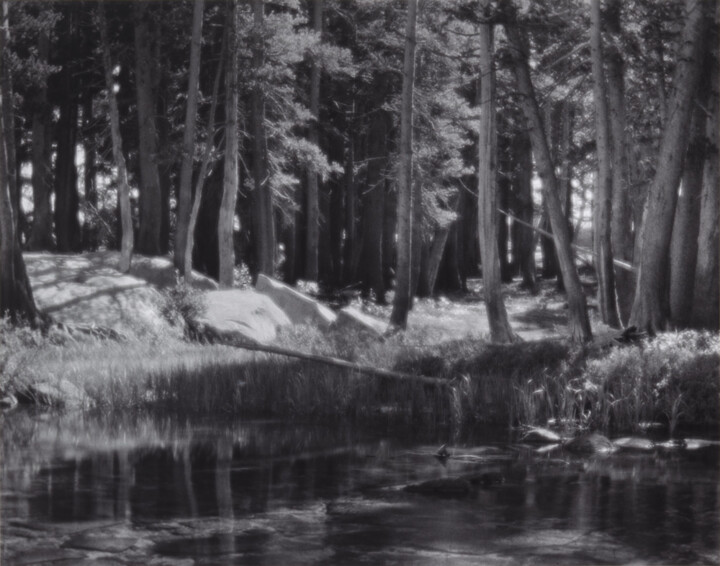 Lodgepole Pines, Lyell Fork of the Merced River, Yosemite National Park (1921) - Ansel Adams, via Wikipedia.
Lodgepole Pines, Lyell Fork of the Merced River, Yosemite National Park (1921) - Ansel Adams, via Wikipedia.
The end of days
On April 22, 1984, Adams passed away at the age of 82 due to cardiovascular disease. He was in the intensive-care unit at the Community Hospital of the Monterey Peninsula in Monterey, California. At the time of his passing, he was surrounded by his wife, children Michael and Anne, and five grandchildren. Following his death, Adams's body was cremated, and his ashes were scattered on Half Dome, located in Yosemite National Park, a place that held deep significance for him.
The publishing rights for the majority of Adams's photographs are managed by the trustees of The Ansel Adams Publishing Rights Trust. A comprehensive collection of his work is housed in the archive at the Center for Creative Photography, which is located at the University of Arizona in Tucson. Many of Adams's pieces have been auctioned, with notable sales including a large-scale print of "Clearing Winter Storm, Yosemite National Park," which fetched $722,500 at Sotheby's New York in June 2010. At the time, it was the highest price ever paid for an original Ansel Adams photograph. This record was later surpassed on December 14, 2020, when another mural-sized print of his photograph titled "The Tetons and the Snake River" sold for $988,000 at Sotheby's New York.
In the introduction to "Ansel Adams: Classic Images," John Szarkowski acknowledges the extraordinary phenomenon of the love and admiration that Americans have consistently expressed for Adams. This outpouring of support began during his later years and has continued with unwavering enthusiasm even after his passing, making it a response to a visual artist that is perhaps unparalleled in the country's history.
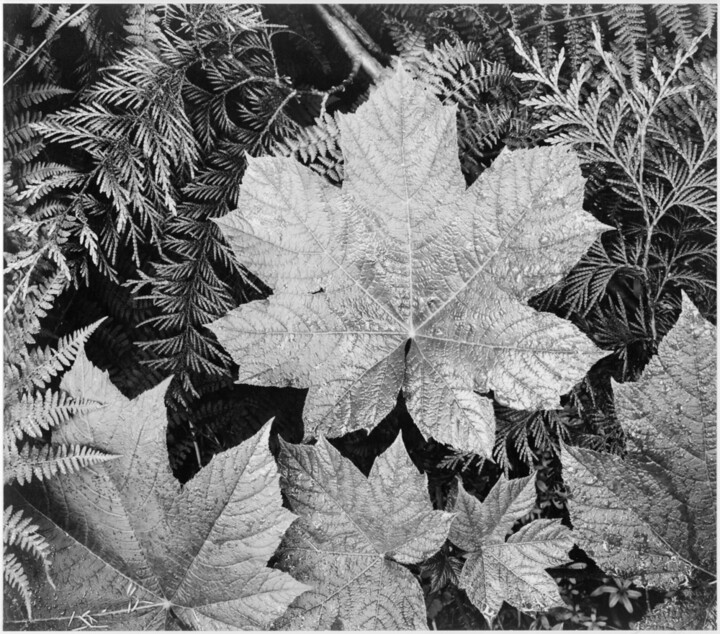 Close-up of leaves In Glacier National Park (1942) - Ansel Adams, via Wikipedia.
Close-up of leaves In Glacier National Park (1942) - Ansel Adams, via Wikipedia.
Photography
Pictorialism
In 1921, Adams's initial photographs were published, and Best's Studio commenced selling his prints of Yosemite the following year. Even in his early works, Adams displayed a meticulous sense of composition and a keen awareness of achieving a balanced distribution of tones. In his letters and correspondence with his family, he expressed his audacity in climbing to the most advantageous viewpoints and braving the harshest elements to capture his images.
During the mid-1920s, the prevailing trend in photography was pictorialism, which aimed to emulate the characteristics of paintings through soft focus, diffused lighting, and other artistic techniques. Adams ventured into experimenting with such methods, including the bromoil process, which involved applying an oily ink onto the paper. An example of this is his photograph "Lodgepole Pines, Lyell Fork of the Merced River, Yosemite National Park" (originally titled "Tamarack Pine"), taken in 1921. By utilizing a soft-focus lens, Adams achieved a radiant luminosity that captured the enchanting ambiance of a summer afternoon.
Although Adams briefly dabbled in hand-coloring his photographs, he declared in 1923 that he would no longer pursue this practice. By 1925, he had completely abandoned pictorialism, opting for a more realistic approach that prioritized sharp focus, heightened contrast, precise exposure, and meticulous darkroom craftsmanship.
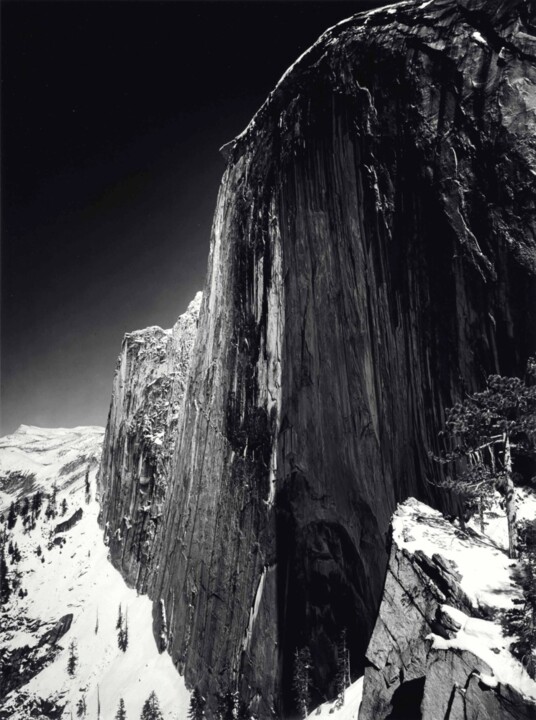 Monolith, the Face of Half Dome, Yosemite National Park, California (1927) - Ansel Adams, via Wikipedia.
Monolith, the Face of Half Dome, Yosemite National Park, California (1927) - Ansel Adams, via Wikipedia.
Monolith
In 1927, Adams embarked on a collaboration with Albert M. Bender, an affluent San Francisco insurance magnate and patron of the arts. With Bender's assistance, Adams produced his inaugural portfolio in his newly developed style, known as Parmelian Prints of the High Sierras. This collection featured his iconic photograph, "Monolith, the Face of Half Dome," which he captured using his Korona view camera, employing glass plates and a dark red filter to intensify the tonal contrasts. During this particular expedition, Adams found himself with only one plate remaining, and before taking the final shot, he "visualized" the desired impact of the darkened sky. Reflecting on the experience, he expressed, "I had managed to achieve the desired image: not how the subject appeared in reality, but how it felt to me and how it should appear in the final print." This photograph, referred to by one biographer as Adams's most significant, marked a departure from traditional photography due to its profound manipulation of tonal values. The concept of visualization, which Adams first articulated in writing in 1934, became a fundamental principle underlying his photographic approach.
The success of Adams's initial portfolio was notable, as it garnered nearly $3,900 in earnings with the support and promotion provided by Bender. Subsequently, he began receiving commercial assignments to photograph the affluent patrons who acquired his portfolio. This period also heightened Adams's awareness of the significance of accurately reproducing his carefully crafted photographs. At Bender's invitation, he became a member of the Roxburghe Club, an association devoted to the art of fine printing and maintaining high standards in book production. Through his involvement, Adams acquired valuable knowledge about printing techniques, inks, design, and layout, which he later applied to various other projects.
In 1928, Adams married Virginia Best, following a brief hiatus from 1925 to 1926 during which he had been involved with different women. To save on expenses, the newlyweds initially moved in with Adams's parents. However, the following year, they had a house constructed next door, connecting it to the older house via a hallway.
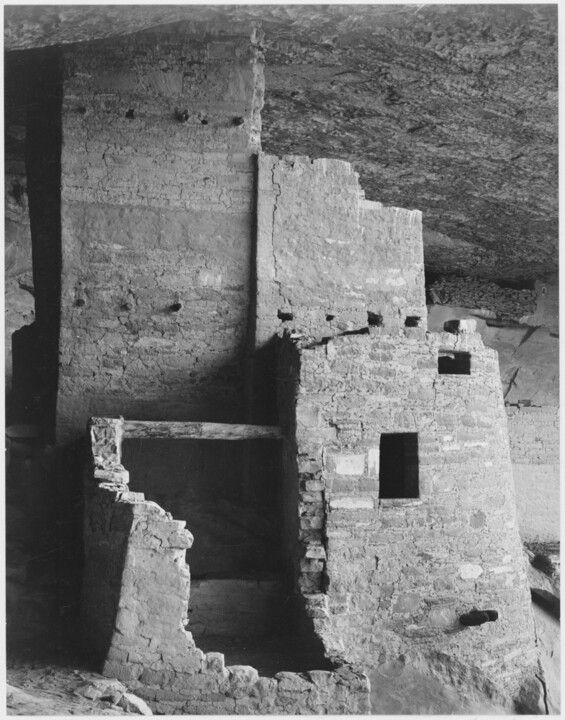
"Castle Geyser Cove, Yellowstone National Park," Wyoming; From the series Ansel Adams Photographs of National Parks and Monuments, compiled 1941 - 1942, documenting the period ca. 1933 - 1942. Via Wikipedia.
Pure photography
From 1929 to 1942, Adams experienced significant growth and solidification in his work, establishing himself as a prominent figure. The 1930s, in particular, proved to be a period of experimentation and high productivity. He expanded the technical scope of his photographs, focusing on intricate close-ups as well as grand subjects ranging from majestic mountains to industrial factories.
During visits to Taos, New Mexico, arranged by Bender, Adams formed acquaintances and friendships with notable individuals in the artistic community, including poet Robinson Jeffers, artists John Marin and Georgia O'Keeffe, and photographer Paul Strand. Adams's lively and talkative nature, coupled with his exceptional piano skills, made him popular among his artist peers. In 1930, his first book, "Taos Pueblo," was published, featuring text by writer Mary Hunter Austin.
Strand had a profound impact on Adams's artistic development. Adams admired the simplicity and meticulousness evident in Strand's negatives, which deviated from the prevalent soft-focus and impressionistic pictorialism of the time. Strand generously shared his technical secrets with Adams and encouraged him to fully pursue photography as his medium of choice. One particular suggestion from Strand that Adams adopted was using glossy paper to enhance the tonal values in his prints.
In 1931, Adams held his first solo museum exhibition at the Smithsonian Institution, titled "Pictorial Photographs of the Sierra Nevada Mountains by Ansel Adams." The exhibition showcased 60 prints capturing the beauty of the High Sierra and the Canadian Rockies. Adams received a favorable review from the Washington Post, with the photographs being likened to portraits of majestic peaks seemingly inhabited by mythical gods.
Despite his accomplishments, Adams believed that he had not yet reached the level of excellence demonstrated by Strand. In response, he decided to expand his subject matter, incorporating still life and close-up photography into his repertoire. He sought to achieve higher quality by meticulously envisioning each image before capturing it. Adams emphasized the use of small apertures and long exposures in natural light, resulting in sharp details and a broad range of focused distances. A prime example of this approach can be seen in "Rose and Driftwood" (1933), regarded as one of his finest still-life photographs.
In 1932, Adams participated in a group exhibition at the M. H. de Young Museum alongside Imogen Cunningham and Edward Weston. Shortly after, they joined forces to establish Group f/64, a collective that championed "pure or straight photography" as opposed to pictorialism. The group's name, f/64, referred to a very small aperture setting that provided extensive depth of field. The group's manifesto emphasized that pure photography should possess no qualities derived from other art forms, focusing on technique, composition, and ideas unique to the medium itself.
Taking inspiration from photographer Alfred Stieglitz, Adams opened his own art and photography gallery in San Francisco in 1933. He also began publishing essays in photography magazines and authored his first instructional book, "Making a Photograph," in 1935.
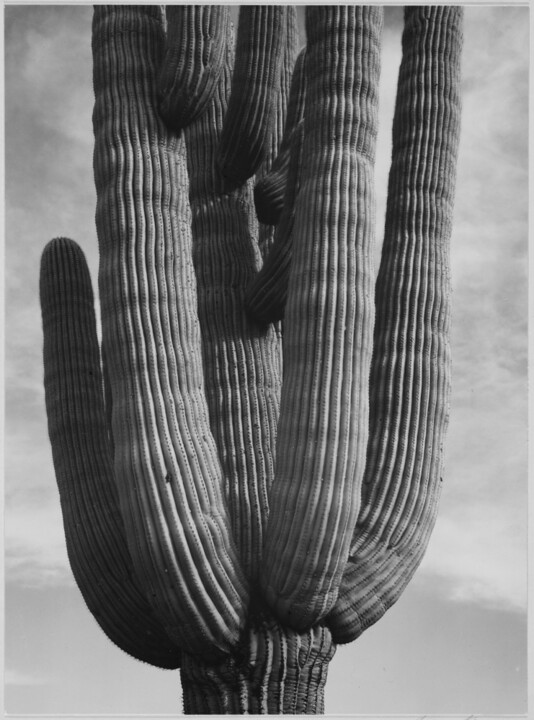
Detail of cactus "Saguaros, Saguro National Monument," Arizona. (Vertical Orientation); From the series Ansel Adams Photographs of National Parks and Monuments, compiled 1941 - 1942, documenting the period ca. 1933 - 1942. Via Wikipedia.
Sierra Nevada
During the summertime, Adams frequently took part in Sierra Club High Trips, where he served as a paid photographer for the group. Meanwhile, throughout the rest of the year, a core group of Sierra Club members regularly gathered for social activities in San Francisco and Berkeley. In 1933, Adams welcomed the arrival of his first child, Michael, followed by the birth of his daughter Anne two years later.
In the 1930s, Adams began utilizing his photographs as a means to advocate for the preservation of wilderness areas. His motivation stemmed, in part, from the growing encroachment of commercial development in Yosemite Valley, including the establishment of facilities like a pool hall, bowling alley, golf course, shops, and increased automobile traffic. To support the Sierra Club's efforts in securing the designation of Kings Canyon as a national park, Adams produced a limited-edition book in 1938 titled "Sierra Nevada: The John Muir Trail." This publication, alongside his testimony before Congress, played a pivotal role in the successful achievement of national park status for Kings Canyon in 1940. In 1935, Adams captured a series of striking photographs showcasing the Sierra Nevada region. Notably, one of his most famous works, "Clearing Winter Storm," depicted the entire expanse of Yosemite Valley just as a winter storm was subsiding, leaving a fresh layer of snow. Combining his recent photographs, Adams organized a solo exhibition at Alfred Stieglitz's renowned "An American Place" gallery in New York in 1936. The exhibition received acclaim from both critics and art buyers, earning Adams high praise from the esteemed Stieglitz himself. However, the following year, disaster struck when the darkroom in Yosemite caught fire, endangering the negative of "Clearing Winter Storm." With the assistance of Edward Weston and Charis Wilson (Weston's future wife), Adams managed to extinguish the fire. Unfortunately, thousands of negatives, including numerous ones that had never been printed, were lost in the incident.

Photograph of Electrical Wires of the Boulder Dam Power Units; From the series Ansel Adams Photographs of National Parks and Monuments, compiled 1941 - 1942, documenting the period ca. 1933 - 1942. Via Wikipedia.
Desert Southwest
In 1937, Adams, O'Keeffe, and their companions organized a month-long camping expedition in Arizona, with Orville Cox, the head wrangler at Ghost Ranch, serving as their guide. It was during this remarkable journey that both artists produced new works. Adams took a candid portrait of O'Keeffe alongside Cox on the precipice of Canyon de Chelly. Reflecting on the experience, Adams once noted, "Some of my most exceptional photographs have been captured within and upon the rim of that canyon." Their respective creations, set in the captivating desert Southwest, have often been exhibited and published together, showcasing their shared exploration of the region.
Throughout the remainder of the 1930s, Adams pursued numerous commercial assignments to supplement the income generated by Best's Studio, which was experiencing financial challenges. He relied on these assignments for financial stability until the 1970s. Among his clients were notable entities such as Kodak, Fortune magazine, Pacific Gas and Electric Company, AT&T, and the American Trust Company. In 1939, Adams had the opportunity to photograph the newly designed Patent Leather Bar by Timothy L. Pflueger, located in the St. Francis Hotel. Additionally, during the same year, he assumed the role of editor for U.S. Camera & Travel, a highly popular photography magazine at the time.
A Pageant of Photography
In 1940, Adams orchestrated the production of A Pageant of Photography, an expansive and highly significant photography exhibition that garnered immense attendance and acclaim in the West. It captivated the interest of millions of visitors who recognized its importance within the realm of photography. During this period, Adams collaborated with his wife on various projects, including the creation of a children's book and the highly successful Illustrated Guide to Yosemite Valley, both of which were completed in 1940 and 1941. Additionally, Adams ventured into the realm of teaching by conducting photography workshops in Detroit. Simultaneously, in 1941, he embarked on his initial foray into more formal teaching engagements. This involved training military photographers and marked the commencement of his teaching career at the Art Center School of Los Angeles, now known as the Art Center College of Design.
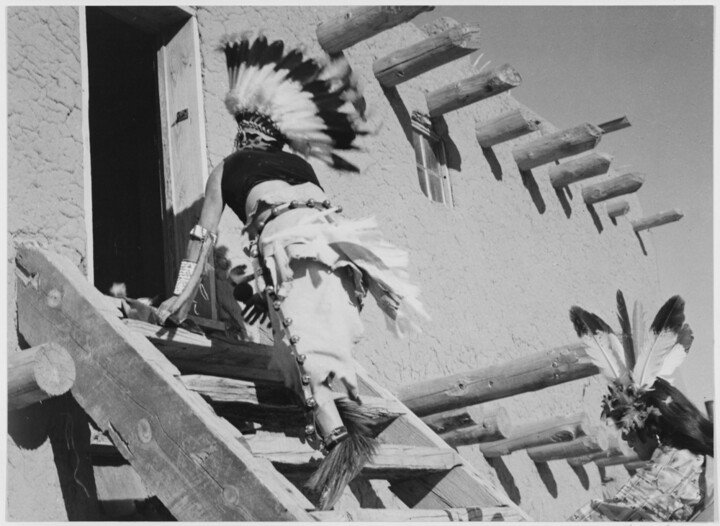 "Dance, San Ildefonso Pueblo, New Mexico, 1942," two Tewa in headdress ascending stairs to house.; From the series Ansel Adams Photographs of National Parks and Monuments, compiled 1941 - 1942, documenting the period ca. 1933 - 1942. Via Wikipedia.
"Dance, San Ildefonso Pueblo, New Mexico, 1942," two Tewa in headdress ascending stairs to house.; From the series Ansel Adams Photographs of National Parks and Monuments, compiled 1941 - 1942, documenting the period ca. 1933 - 1942. Via Wikipedia.
Mural Project
In 1941, Adams entered into an agreement with the National Park Service to capture photographs of various National Parks, Indian reservations, and other sites under the department's jurisdiction. The purpose was to create large-scale mural prints that would adorn the department's newly constructed building. The contract specified a duration of 180 days. To fulfill this endeavor, Adams embarked on a journey alongside his friend Cedric and his son Michael. Their plan encompassed combining efforts for the "Mural Project" with commissioned assignments for the U.S. Potash Company and Standard Oil. They allocated specific days for personal photographic pursuits as well.
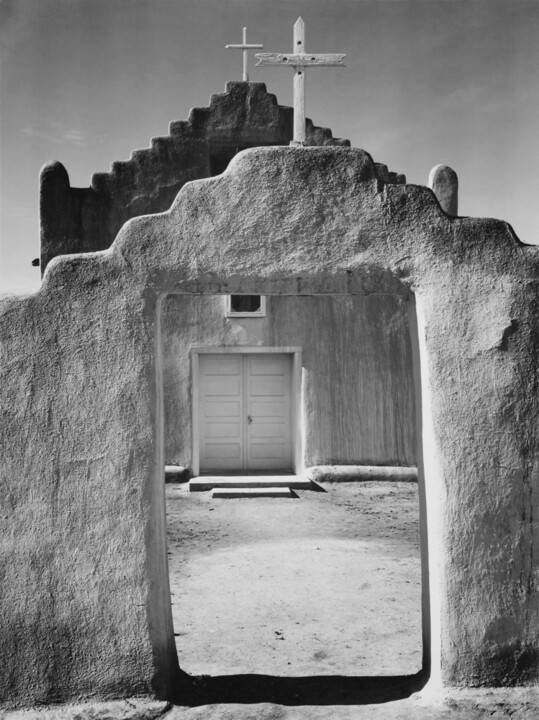 Front view of entrance, "Church, Taos Pueblo National Historic Landmark, New Mexico, 1942" [Misicn de San Gercnimo] (vertical orientation); From the series Ansel Adams Photographs of National Parks and Monuments, compiled 1941–42, documenting the period ca. 1933–42. Via Wikipedia.
Front view of entrance, "Church, Taos Pueblo National Historic Landmark, New Mexico, 1942" [Misicn de San Gercnimo] (vertical orientation); From the series Ansel Adams Photographs of National Parks and Monuments, compiled 1941–42, documenting the period ca. 1933–42. Via Wikipedia.
Moonrise
During his time in New Mexico for the project, Adams captured a remarkable scene that would become one of his most renowned photographs. The image showcased the Moon rising above a modest village, framed by snow-covered mountains against a dominant black sky. This iconic photograph, named "Moonrise, Hernandez, New Mexico," gained further notoriety due to Adams's later descriptions of its creation. According to his accounts, the light on the crosses in the foreground was rapidly diminishing, and he couldn't locate his exposure meter. However, he relied on his memory of the Moon's luminosity to calculate the appropriate exposure. In an earlier recollection, Adams provided a more straightforward explanation, stating that the photograph was taken after sunset, with exposure determined using his Weston Master meter.
Regardless of the exact method used to determine the exposure, the resulting negative presented challenges during printing. The foreground appeared underexposed, while the highlights in the clouds appeared dense. "Moonrise" was initially published in the 1943 annual edition of U.S. Camera after being selected by the esteemed "photo judge," Edward Steichen. This early exposure allowed the photograph to reach an audience before its first official exhibition at the Museum of Modern Art in 1944.
Over the course of nearly four decades, Adams revisited and reinterpreted this immensely popular image, utilizing the latest darkroom equipment available to him. He produced over 1,369 unique prints, predominantly in a 16" by 20" format. Many of these prints were created in the 1970s, and their subsequent sale granted Adams financial independence from commercial projects. The collective value of these original prints now exceeds $25,000,000, with the highest price ever paid for a single print of "Moonrise" reaching $609,600 at a Sotheby's auction in New York in 2006.
The Mural Project concluded on June 30, 1942, and due to the onset of World War II, the planned murals were never realized. Adams sent a total of 225 small prints to the Department of the Interior (DOI) but retained possession of the 229 negatives. Among these negatives were numerous renowned images, including "The Tetons and the Snake River." While legally the property of the U.S. Government, Adams was aware that the National Archives did not adequately preserve photographic materials and employed various tactics to avoid inquiries.
One image, in particular, sparked interest regarding ownership: "Moonrise." Although Adams meticulously recorded his travel and expenses, he was less meticulous in documenting the specific dates of his photographs. Unfortunately, he failed to note the date of "Moonrise." However, based on astronomical calculations and the position of the Moon, the image was eventually dated to November 1, 1941, by Dennis di Cicco of Sky & Telescope in 1991. As Adams had not billed the department for that particular day, the image rightfully belonged to him.
 "Formations, a few of many natural formations at Carlsbad Caverns. Carlsbad Caverns National Park," New Mexico. (vertical orientation); From the series Ansel Adams Photographs of National Parks and Monuments, compiled 1941 - 1942, documenting the period ca. 1933 - 1942. Via Wikipedia.
"Formations, a few of many natural formations at Carlsbad Caverns. Carlsbad Caverns National Park," New Mexico. (vertical orientation); From the series Ansel Adams Photographs of National Parks and Monuments, compiled 1941 - 1942, documenting the period ca. 1933 - 1942. Via Wikipedia.
World War II
When Edward Steichen established the Naval Aviation Photographic Unit in early 1942, he extended an invitation to Adams to join as a member and oversee the construction and management of an advanced darkroom and laboratory in Washington, D.C. Around February 1942, Steichen formally approached Adams to join the navy. Adams accepted the offer, but with certain conditions: he requested to be commissioned as an officer and expressed his availability only from July 1 onward. Since Steichen aimed to assemble the team as swiftly as possible, he proceeded without Adams and had his other photographers ready by early April.[98]
Adams felt deeply troubled by the internment of Japanese Americans following the attack on Pearl Harbor. Driven by a sense of urgency, he sought permission to visit the Manzanar War Relocation Center located in the Owens Valley near Mount Williamson. The result was a photo-essay that initially featured in an exhibit at the Museum of Modern Art and later became the published work "Born Free and Equal: The Story of Loyal Japanese-Americans." However, the book faced resistance and was rejected by many who deemed it disloyal. This project marked a significant departure, both stylistically and philosophically, from Adams's more familiar body of work. Additionally, Adams made valuable contributions to the war effort by undertaking various photographic assignments for the military, including the production of prints showcasing secret Japanese installations in the Aleutian Islands.
In 1943, Adams took a unique approach to his photography by mounting a camera platform on his station wagon. This allowed him to capture improved perspectives of the immediate foreground and expansive backgrounds. Consequently, many of his landscape photographs from this period were taken from the roof of his car rather than scaling rugged summits as he had done in his earlier years.
Throughout his career, Adams was honored with three Guggenheim Fellowships. The first fellowship, granted in 1946, was specifically awarded to document each national park in the United States. At that time, there were 28 national parks, and Adams successfully photographed 27 of them, with Everglades National Park in Florida being the sole exception. This project yielded memorable images of iconic landmarks such as Old Faithful Geyser, Grand Teton, and Mount McKinley.
In 1945, Adams was entrusted with establishing the first fine art photography department at the California School of Fine Arts. As part of this initiative, he invited notable photographers Dorothea Lange, Imogen Cunningham, and Edward Weston to serve as guest lecturers, while Minor White assumed the role of principal instructor. The photography department went on to nurture numerous noteworthy photographers, including Philip Hyde, Benjamen Chinn, and Bill Heick.
 Erupting, against dark sky, "Old Faithful Geyser, Yellowstone National Park," Wyoming - Ansel Adams, via Wikipedia.
Erupting, against dark sky, "Old Faithful Geyser, Yellowstone National Park," Wyoming - Ansel Adams, via Wikipedia.
1950s
In 1952, Adams played a pivotal role in the establishment of Aperture magazine, which aimed to serve as a prestigious publication showcasing the finest practitioners and latest developments in photography. Simultaneously, he contributed to Arizona Highways, a travel magazine renowned for its visually captivating content. One of Adams's notable works for the magazine was an article on Mission San Xavier del Bac, which was later expanded into a book published in 1954. This marked the beginning of a fruitful collaboration with his longtime friend Nancy Newhall.
Starting in June 1955, Adams commenced his annual workshops held at Yosemite. These workshops continued until 1981 and garnered the participation of thousands of students eager to learn from his expertise. Adams also remained engaged in commercial assignments for another two decades and took on a consulting role for Polaroid Corporation, a company founded by his close friend Edwin Land, receiving a monthly retainer for his services. He extensively utilized Polaroid products to capture thousands of photographs, with "El Capitan, Winter, Sunrise" (1968) being one of his most memorable works. Throughout the latter part of his life, Adams favored the 6x6 cm medium format Hasselblad camera, considering "Moon and Half Dome" (1960) as his personal favorite image captured with that brand.
From 1957 to 1962, Geraldine "Gerry" Sharpe served as Adams's photography assistant, often capturing photographs alongside him at the same locations.
In 1963, Adams released his fourth portfolio titled "What Majestic Word," dedicated to the memory of his Sierra Club comrade Russell Varian. Russell, who co-invented the klystron, had passed away in 1959. The portfolio's title was derived from the poem "Sand Dunes" written by Russell's father, John Varian, and it featured fifteen photographs accompanied by writings from both John and Russell Varian. The preface was penned by Russell's widow, Dorothy, who explained that the selected photographs were intended to serve as interpretations of Russell Varian's character.
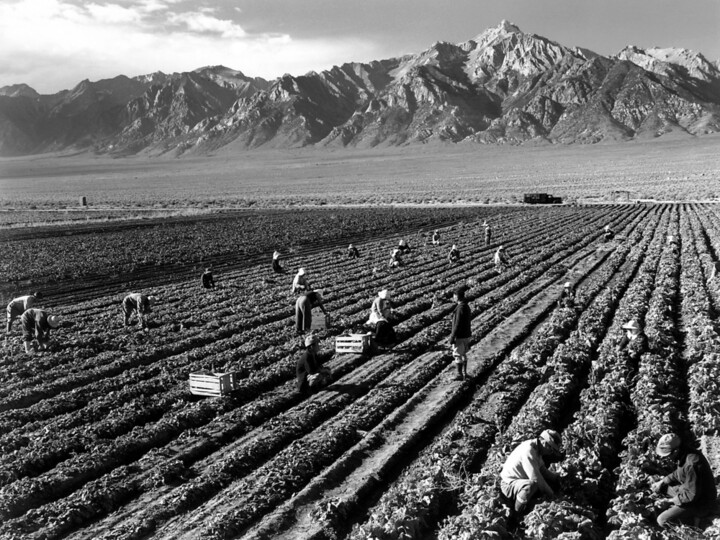 Farm, farm workers, Mt. Williamson in background, Manzanar Relocation Center, California - Ansel Adams, via Wikipedia.
Farm, farm workers, Mt. Williamson in background, Manzanar Relocation Center, California - Ansel Adams, via Wikipedia.
Later career
By the 1960s, Adams's health was affected by gout and arthritis, leading him to seek a new home in hopes of finding relief. Although they considered Santa Fe, both Adams and his wife had commitments in California, with Virginia managing her father's Yosemite studio. A friend offered them property in Carmel Highlands, offering a picturesque view of the Big Sur coastline. Collaborating with architect Eldridge Spencer, they embarked on planning their new home in 1961 and eventually relocated there in 1965. Adams dedicated a significant portion of his time to printing the extensive backlog of negatives that had accumulated over the course of forty years.
During the 1960s, a shift occurred in the perception of photography as several mainstream art galleries, previously hesitant to exhibit photographs alongside fine paintings, recognized the value of Adams's work. Notably, the former Kenmore Gallery in Philadelphia decided to showcase his images.[116] In March 1963, Ansel Adams and Nancy Newhall accepted a commission from Clark Kerr, the president of the University of California, to create a series of photographs capturing the university's campuses in commemoration of its centennial celebration. The resulting collection, titled "Fiat Lux" after the university's motto, was published in 1967 and is currently housed in the Museum of Photography at the University of California, Riverside.
Throughout the 1970s, Adams reprinted negatives from his extensive vault, responding to the growing demand from art museums that had recently established photography departments. In 1972, he contributed his images to support Proposition 20, which aimed to authorize state regulations on development along specific areas of the California coast. Additionally, Adams exhibited his work at the Rencontres d'Arles, an annual photography festival in France, in 1974, and had a significant retrospective exhibition at the Metropolitan Museum of Art. Furthermore, he played a pivotal role in the founding of the Center for Creative Photography at the University of Arizona in 1975, which now manages certain aspects of his estate.
In 1979, President Jimmy Carter commissioned Adams to capture the first official photographic portrait of a U.S. president.

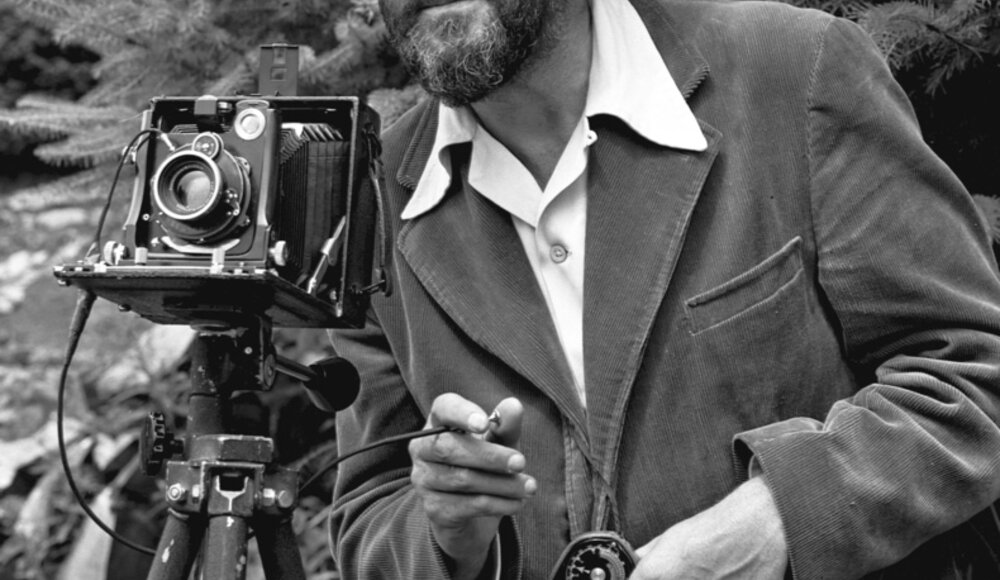
 Olimpia Gaia Martinelli
Olimpia Gaia Martinelli